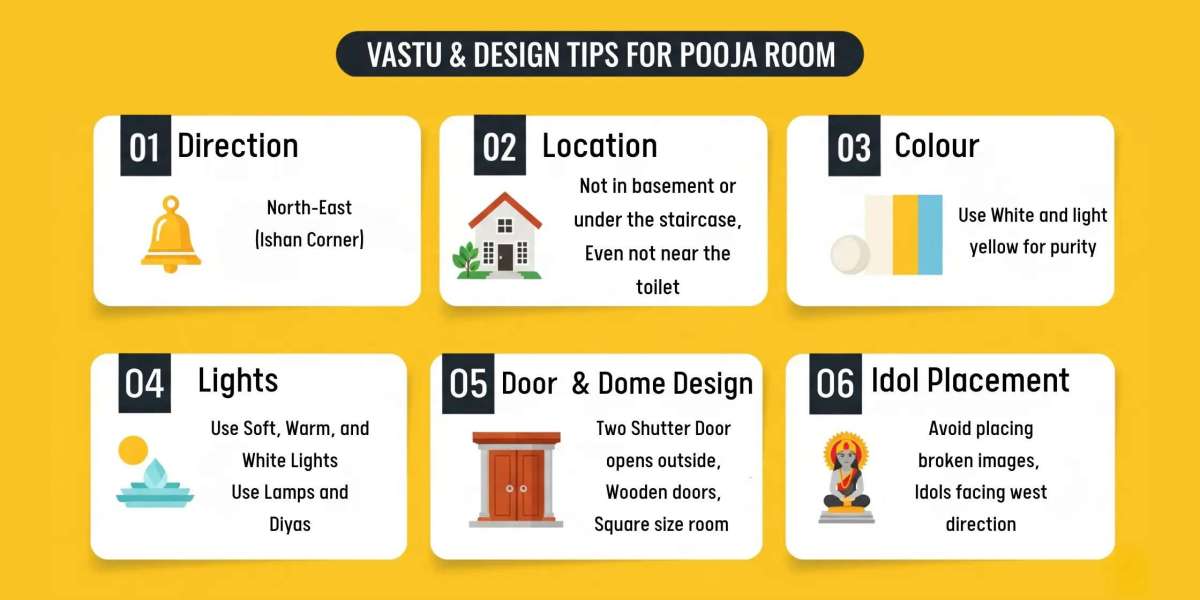Designing a pooja room as per Vastu is not just about aesthetics—it’s about channeling spiritual energy and positive vibrations into your home. According to Vastu for pooja room guidelines, the right placement, direction, and design elements can significantly impact the peace and prosperity of your household. In this article, we will explore the ideal pooja room design as per Vastu, helping you create a sacred space that aligns with universal energy and enhances spiritual well-being.
Ideal Location and Direction for Pooja Room
The location of your pooja room plays a vital role in Vastu Shastra. It directly influences the energy flow in your home and the sanctity of your prayers.
Northeast (Ishan Kona) is considered the most auspicious direction.
If not feasible, East or North is the next best choice.
Avoid placing the pooja room in bedrooms, bathrooms, or directly under stairs.
In multi-story homes, it’s best to place the pooja room on the ground floor, keeping it separate from high-activity or impure areas.
Why it matters: According to Vastu for pooja room, the northeast direction attracts cosmic energy and fosters mental clarity during prayers and meditation.
Design Elements to Include in Pooja Room
To enhance positivity, follow these design tips while setting up your pooja room design as per Vastu:
Mandir Material: Choose natural materials like marble, wood, or granite. Avoid glass or acrylic mirrors.
Doors and Curtains: The pooja room should have two shutters or a curtain, ideally made of wood or cloth in earthy tones.
Flooring: Opt for white or light-colored marble flooring to maintain purity.
Ceiling: Go for a low-height ceiling or a pyramid-style roof to concentrate energy flow.
Decorate the space with fresh flowers, incense sticks, and holy symbols like Swastik, Om, and Lotus, which align well with Vastu for pooja room principles.
God Placement and Facing Direction
When it comes to placing deities inside the mandir, Vastu provides specific recommendations:
Idols should face West or East, so you face East or West while praying.
Ensure idols are not directly placed on the floor—use a pedestal or wooden chowki.
Keep a minimum distance of 1 inch from the wall to allow energy flow.
Avoid placing multiple idols of the same deity and ensure no broken or chipped statues are kept in the pooja space.
Lighting and Storage in the Pooja Room
Lighting plays a symbolic and energetic role in the pooja room. Here’s how to use it wisely:
Install a diya or oil lamp in the southeast corner.
Use soft, warm lighting—preferably yellow or golden—to enhance the sacred ambiance.
Avoid harsh, blue-toned LEDs.
For storage:
Place cupboards or drawers in the south or west walls.
Use the space to keep religious books, pooja materials, and incense.
Ensure that the area is clutter-free, as a messy pooja room obstructs energy flow and contradicts Vastu for pooja room rules.
Conclusion
Designing a pooja room as per Vastu invites divine energy, mental peace, and spiritual discipline into your home. From choosing the right direction and materials to following Vastu-approved design rules, every element matters. Whether you’re building a new mandir or remodeling your current one, these insights help you create a sacred space that resonates with cosmic harmony.
If you’re looking to get your pooja room perfectly aligned with Vastu principles, consult the experts at Samanvay Vastu. We specialize in crafting personalized, auspicious spaces, ensuring your pooja room design as per Vastu, brings lasting positivity and devotion into your life.







